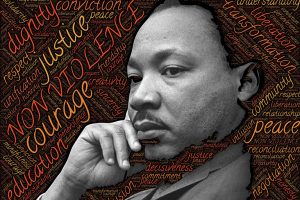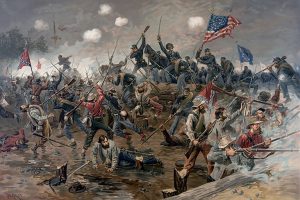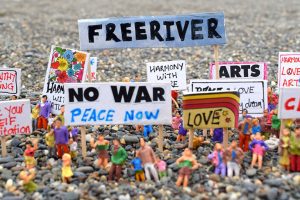“They (terrorists) hate what they see right here in this chamber: a democratically elected government. Their leaders are self-appointed. They hate our freedoms: our freedom of religion, our freedom of speech, our freedom to vote and assemble and disagree with each other.” – George W. Bush
Ask any “patriot” what is great about the United States and they will use the word freedom. If you ask them why we are at war, they will say to protect our freedom. If you ask what our country was founded on, they will tell you Christianity…and freedom. Is there any truth to that?
WHAT?! The “land of the free?” Whoever told you that is your enemy! – Zack de la Rocha
There are attempts to measure freedom. Heritage foundation indexes “economic freedom,” placing the U.S. at 18. This is behind Hong Kong, Singapore, Australia, New Zealand, and a large swath of the EU. Cato Institute also ranks our “economic freedom” at 17th, while ranking our “personal freedom” at 24th. If one points this out, we are reminded that “they can’t own guns,” which is a topic for another article. Europeans have expressed amazement at America’s obsession with freedom while having the highest prison population on earth. Were we really free at some point and our country has collapsed until we’ve reached this point? This article will explore what freedom is in the United States and if we really have any. Due to the scope of the article, it will be broken into sections.
African-Americans

While there were slaves of different races, and the issues of discrimination that faces African-Americans far exceeds the scope of slavery, the two topics are undeniably linked throughout history. The repercussions of slavery still exist to this day. That is why these two topics are dealt together.
“We hold these truths to be self-evident, that all men are created equal…” – Declaration of Independence
41 of the 57 signers of the declaration on independence owned slaves.
In the 1600’s, all colonies had legalized slavery. Without going into details, by the time the U.S. declared independence, slavery was well established. During the revolutionary war, several states in New England made slavery illegal, bandned the importation of more slaves, and/or freed enslaved men. In practice, however, slavery persisted in these states until the mid-1800’s, when a combination of moral outrage and economics finally freed them. The Constitution declared that slaves could be imported until 1808. This wasn’t much of an issue, since survival rates for slaves in the United States were much better than the Caribbean and South America, meaning slaves were able to be bred. The father north you went, the demand for slaves decreased. There was (through births) a surplus in the north, leading a trade developed internally, with young slaves from the north being sold to southern plantations who were desperate for more labor. There was also a provision in the Constitution insuring that a slave would be returned to his master, even if he escapes to a free state.
Side Bar:
Georgetown University, arguable one of the world’s most elite institutions, saved itself during financial hardship in 1838 sold slaves to the south.
In 1794, the cotton gin is invented, making industrialized production of cotton a reality. This very labor-intensive crop become very profitable in states with hot climates…and slave labor. This invention solidifies the division between north and south, with the south becoming dependent on slave labor. As the Constitutional ban on laws regarding slave imports expires in 1808, the federal government bans the importation of slaves. The rapidly expanding demand for labor and easy access to the Caribbean means slave smuggling becomes common.
In 1840, Richard Hildreth commented that duels were “are of frequent and almost daily occurrence at the south.” Being armed was a strong tradition in the south because of the “quarrels between freemen” and also as protection against slaves. The fear (and bizarre obsession with firearms) that dominates society today was developing.
During the early 1800’s, America was going through a moral crisis. Many people knew slavery was wrong, but it sure was lucrative (a common theme throughout U.S. history). The belief that it was “a necessary evil” developed, which was simply that slavery couldn’t be safely ended. Thomas Jefferson said, in 1820, “We have the wolf by the ear, and we can neither hold him, nor safely let him go. Justice is in one scale, and self-preservation in the other.” Farther South, attitudes were starker. John C. Calhoun said slaves in the South were better off than freemen in Europe. While George Fitzhugh stated southern slaves were the freest people on Earth, and implied that slaves (i.e. the people that did ALL THE WORK) were too lazy to survive on their own. The Bible itself specifically supported slavery, and all the great men of the Old Testament owned slaves. There were even instructions on how much you could beat your slaves. This all lead southern Christians to feel divine support for the “peculiar institution.” In fact, slavery was honored as a way to “civilize” the “heathens.” In other words, being a Christian slave was better than being a “heathen” freeman. This all also reinforced the belief than Africans (and natives) were “lesser” creations and below the station of the white Europeans. These beliefs would become so ingrained in the culture of the south that their influence is felt even today.
In the war of 1812, the British offered freedom to any slave who defected and fought. Hundreds of slaves joined the Colonial Marines and fought alongside the British. Our national anthem was written about this war and includes the verse,
Their blood has wash’d out their foul footstep’s pollution.
No refuge could save the hireling and slave
From the terror of flight or the gloom of the grave,
And the star-spangled banner in triumph doth wave
O’er the land of the free and the home of the brave.
This reference (hireling and slave) is a reference to the Colonial Marines who fought alongside the British. Our national anthem literally has a verse in it about killing escaped slaves. The glorious battle of Fort McHenry was an embarrassment as well. The British remained at their extreme range during their bombardment, not wanting to risk any casualties themselves. To the British, this war was just a minor inconvenience, while to the U.S. it was a major event in their history. While the America’s won the Battle (they didn’t allow access to the harbor), they suffered four dead and twenty-four wounded, while the Brits had one wounded. So, there was no real need for the afore mentioned refuge. After the war, the freemen were moved to Nova Scotia, Florida, or the Caribbean. The War ended by treaty, and the slave owners demanded their slaves returned. The British refused to place freemen back in bondage and agreed to pay reparations. As the UK withdrew its troops, they left a Fort in north Florida a Fort near the US border for their Colonial Marines (and recently enslaved) to occupy. It received the unfortunate name of Negro Fort and became a lightning rod for escaped slaves and freedom fighters. Although heavily armed and trained Colonial Marines, other free blacks, and Seminole and Choctaw Indians inhabited the area, they had no artillery (the most important part of fortifications) and in 1816 (after the War of 1812 was over) the US illegally invaded Spanish Florida to destroy the fort. This is an interesting story on its own, and may get an article at a later date, but suffice it to say the “good guys” destroyed the fort, killed all the survivors (except the ones that were worth selling back into slavery), and gave the Creek Indian allies all the spoils, including a massive store of weapons and ammo. This shifted the balance of power to their tribe and prepared the region for the Seminole Wars a few years later.
In 1854, President Franklin Pierce signs the Kansas–Nebraska Act which allowed slaves to be brought to the new territories. The Republican Party is formed afterwards as a radical anti-slavery platform. In 1857, the Dredd Scott ruling states that Africans can never be citizens, the federal government can neither free slaves, nor tell new states they cannot own slaves. In 1960, Abraham Lincoln is elected. The Civil War begins one year later and lasts until 1864.
The Civil War

Our new Government is founded upon exactly the opposite ideas; its foundations are laid, its cornerstone rests, upon the great truth that the negro is not equal to the white man; that slavery, subordination to the superior race, is his natural and moral condition
Vice President of the Confederacy Alexander Stephens
With the north pushing more and more towards eliminating slavery all together, the south began to make other plans. Their fear of many things, the destruction of their profitable industry (which benefited only a small percentage of the population), the open racism and disdain for blacks, and the thought of what may happen when the massive population of slaves gets the freedoms reserved for whites only, like the right of bear arms.
That year the 13th Amendment is ratified and slavery is now illegal in the united states. 1866 is a pivotal year. The Southern states begin passing the “Black Codes”, which are laws greatly restricting freedom of the newly freed slaves and mark the beginning of the industrial prison system while the federal government passes laws granting slaves their citizenship and guarantying their equal rights. The Ku Klux Klan is formed to intimidate blacks and their supporters. The 14th Amendment is ratified, overturning Dredd Scott and creating a permanent right to citizenship. The federal government had occupational troops in the south to enforce the new rights for former slaves until the election of Hayes in 1877. That election as very close and contested by both parties. The Democrats intimidated black votes in the south, and the results promised to be contested for months. The Republicans made a deal. If the Democrats would concede the election to the stanch abolitionist Hayes, they federal government would remove troops from southern states. This was a horrifically bad decision whose repercussions are still felt in southern states today. State governments and individual citizens, not to mention terrorist organizations like the Ku Klux Klan, were now allowed to run rampant on the rights of blacks in the South. Widespread violence and institutionalized racism became the norm. After the Civil War, there was a long-term migration out of the south. First to the West, then the North. The scale varied year to year, becoming much more pronounced during times of violence in the south, and during high demand periods of northern industry.
In 1881, the first Jim Crow laws are passed. The term “Jim Crow” itself was fairly racist, as it is a reference to a mistral song from 1832. By 1881, this term was clearly a racial slur. These laws are the segregation laws that forced blacks to use separate facilities in most aspects of life. Separate but equal was the term, but in reality, facilities for black were dramatically underfunded, or nonexistent. This widespread attack on the rights of former slaves would be upheld as constitutional in 1896. Woodrow Wilson, although commonly thought as a progressive, was the first Democrat elected President since before the Civil War. He instated federal segregation in the workplace at the suggestion by his southern base.
SIDE BAR:
This is a good time to point out that political parties shift over time. There have been six political eras in our two-party system, and each era is marked by different priorities and affiliations. While this is a topic for another day, suffice it to say that the liberal, progressive Republican party of the 1860’s was not the same as the conservative Wall Street centered party of the 1930’s.
The National Housing Act of 1934 began the practice of redlining in earnest. This is simply the banks drawing redlines around neighborhoods that were considered “bad investments” and barring capital investments in those areas. This doomed black communities to lack of funds to build and buy into neighborhoods. This was not a minor issue. As late as 2017, the Central Bank of Chicago release a study on the effect being felt today from redlining dating back to 1934. (source)
“As a consequence of redlining, neighborhoods that local banks deemed unfit for investment were left underdeveloped or in disrepair. Attempts to improve these neighborhoods with even relatively small-scale business ventures were commonly obstructed by financial institutions that continued to label the underwriting as too risky or simply rejected them outright. When existing businesses collapsed, new ones were not allowed to replace them, often leaving entire blocks empty and crumbling. Consequently, African Americans in those neighborhoods were frequently limited in their access to banking, healthcare, retail merchandise, and even groceries.” – Brent Gaspaire
With the federal government fully endorsing segregation, it would take several decades filled with atrocities until 1954, when the Supreme Court ruled segregation was unconstitutional. Southern States fought back against this concept variously. It was this period in history that most of the Civil War statues were placed in public in the south as well as confederate battle flags being flown on State property. A year later, Rosa Parks was arrested for not giving up her seat on a city bus. Finally, in 1957, Dr Martin Luther King, Jr formed the Southern Christian Leadership Conference, which became the hammer of the civil rights movement.
SIDE BAR:
Georgia redid its flag in 1956 to feature the “stars and bars” officially and kept this until 2001. In 2003, they once again redid their flag to a design based on the first national flag of the confederacy.
1960’s

By 1960, the untired states had spent eight of the last twenty years at war. The Cold War had begun, war in Vietnam was in full force, and the United States took its first few steps into full involvement, and the threat of nuclear war became a grim reality. In the face of this, the far left in our country began to fight back.
In 1964, the Civil Rights Act is signed, radically changing the concept of acceptable behavior in our country. One year later, the Voting rights Act is passed, forcing southern states to allow minorities of all types to vote. These rights were finally in place, but the fight to actualize these rights had just begun. Since the end of WW2, the resurgence of the Ku Klux Klan had begun in earnest. Several city and state governments (especially police departments) were either complacent with their activities or had many officers as members. The FBI began to enforce strict laws from the 1870’s to combat this treat, but also viewed civil rights organizations as subversive and spent more resources investigating them than going after terrorist organizations like the KKK.
This revolution of civil rights was met with a stern backlash. While many Americans welcomed the changes, there was a strong segment of the population than was not happy at all. In the late 1960’s, Black Panthers began armed patrols of their neighborhood, which prompted the immediate repeal of open carry laws in California by governor Ronald Reagan. Those same fears from the 1800’s (remember the southern tradition of being armed at all times) began to reform. These laws, after all, were put in place for white men.
“The Nixon campaign in 1968, and the Nixon White House after that, had two enemies: the antiwar left and black people. You understand what I’m saying? We knew we couldn’t make it illegal to be either against the war or black, but by getting the public to associate the hippies with marijuana and blacks with heroin, and then criminalizing both heavily, we could disrupt those communities. We could arrest their leaders, raid their homes, break up their meetings, and vilify them night after night on the evening news. Did we know we were lying about the drugs? Of course we did.”
– John Ehrlichman
America began its war on blacks drugs. While Nixon was foiled by his impeachment, the machine he emplaced began to find its footing in the early 1970’s. By mid-decade, prisons were beginning to fill up. Reagan’s election in 1980 was like pouring gasoline on a fire Incarcerations rates exploded. In 1986, laws were put in place that created a 100 to 1 sentencing disparity between powder cocaine and crack cocaine. In other words, the penalty for 500 grams of powered cocaine (used predominately by whites) was the same as the penalty for 5 grams of crack cocaine (predominately used by blacks).
While there have been many gains since 1964, most of those gains have occurred in middle class families, while the lower half of black society still suffers many of the same ills of the 1950’s. Coupled with other economic factors, most notably the rise of income disparity across the board and stagnant wages, the plight of many blacks in the United States is still a major issue. The state of Alabama has the highest poverty rate in the developed world. (source) In 2018, some (black and Latino) neighborhoods in Alabama have open sewers.
The freedom of African-Americans in the United States has never been given. From earliest history they were just property, and the road to any freedom was both bloody and long. While the conditions today are arguably the best in our history, it is nowhere near equal or just. If you are looking for America’s “freedom” you will not find it here.
Stay subscribed! Coming in the next few weeks will be economic freedom, the treatment of Native Americans, and America’s war on other freedoms.
To read the rest of this series, click here





